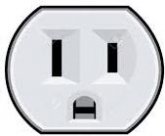You mentioned, "I would like 3 outlet plugs (50amp RV plug, 30amp RV plug, 20 amp standard house plug).". In order to supply all outputs simultaneous at their rated loads you would need an inverter(s) capable of supplying 100A + 25% wiggle-room at 110V or 13,750W. That is a very, very big power demand, but let's roll with it...
Cables above 250A start getting very big, and very expensive, very quickly. 250A at 48V (nominal) only gets you to 12,000W so, unless you want to go up to 96V (niche) then you're looking at at least two inverters sharing the load. 24V (nominal) is, imho, simply not an option for this application.
@tictag I can't speak for OP but I can give you some context as to things in North America. "50A" 30A" and "20A" in the context of RV's in America refer to the three standard 'services' at RV parks / campgrounds, and each has its own distinct plug
In my limited experienced, RV'ers often use these terms to refer to plug type + ballpark power level, as opposed to specific current or power requirements.
I suspect OP wants all three plug types for versatility but will not be using more than one at a time, but this is just speculation.
But still 12kw / 240v, is still a tall order (~275A from the batteries @ 48v)
OP: You can use adapters for the various plug types, might simplify things a bit.







